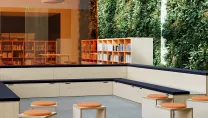In today's fast-paced business environments, the integration of technology with business furniture has become imperative for enhancing office functionality and communication.
The synergy between business furniture, workplace collaboration, and modern office interior design creates an environment that fosters productivity, creativity, and efficiency. By strategically incorporating technology into office interior design, organisations create offices that are not only aesthetically pleasing but also highly functional, enhancing collaboration.
One of the key aspects of integrating technology with business furniture is to prioritise connectivity. In the modern workplace, seamless communication is essential for teamwork and collaboration. Furniture such as desks, conference tables, and lounge seating can be equipped with built-in power outlets, USB ports, and wireless charging pads. This allows employees to stay connected to their devices without the hassle of tangled cords or searching for power sources, promoting uninterrupted workflow and communication.
Integrating technology with furniture enhances workplace collaboration by facilitating interactive meetings and brainstorming sessions. For instance, conference tables equipped with integrated touchscreen displays or interactive whiteboards enable participants to share ideas, annotate documents, and collaborate in real-time. This not only encourages active engagement but also streamlines decision-making processes, leading to more efficient meetings and project execution. Sharp have a communicate and collaborate range of mobile AV furniture that is designed to fulfil the requirements of a modern workplace. The range includes collaboration tables, digital signage stands and display stands that accommodate both hybrid and in-person meetings by creating a collaborative environment.
Modern office interior design is enhanced by incorporating smart furniture solutions that adapt to the evolving needs of the workforce. For example, adjustable height desks equipped with sensors can automatically adjust to the preferred height of individual users, promoting ergonomic comfort and enhancing overall well-being. Similarly, modular furniture systems allow for flexibility and customisation, enabling organisations to reconfigure office layouts according to changing requirements without the need for extensive renovations.
Incorporating technology into furniture design also opens opportunities for innovative solutions to common workplace challenges. For example, acoustic furniture equipped with sound-absorbing materials or noise-cancelling technology can help mitigate distractions in open office environments, promoting a quieter and more focused atmosphere for tasks requiring concentration. Likewise, privacy pods or modular partitions equipped with built-in communication tools offer employees a quiet space for focused work or confidential discussions without sacrificing connectivity.
The integration of technology with furniture aligns with sustainability goals by promoting energy efficiency and reducing waste. Smart furniture solutions equipped with energy-saving features such as motion sensors or power-saving modes help minimise energy consumption and lower operational costs.
In conclusion, the integration of technology with business furniture represents a significant opportunity for organisations to enhance office functionality, communication, and collaboration.
By leveraging innovative solutions in business furniture design, workplace collaboration, and modern office interior design, organisations are able to create dynamic work environments that empower employees to succeed in today's digital age. Embracing technology-integrated furniture not only enhances productivity and efficiency but also reinforces an organisation's commitment to innovation, sustainability, and employee well-being.
Sharp have a dedicated workplace solutions team that are on hand to integrate technology and furniture solutions to keep organisations up to date with the modern workplace requirements.





